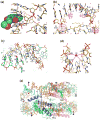Nucleosome structural studies
- PMID: 21176878
- PMCID: PMC3052702
- DOI: 10.1016/j.sbi.2010.11.006
Nucleosome structural studies
Abstract
Chromatin plays a fundamental role in eukaryotic genomic regulation, and the increasing awareness of the importance of epigenetic processes in human health and disease emphasizes the need for understanding the structure and function of the nucleosome. Recent advances in chromatin structural studies, including the first structures of nucleosomes containing the Widom 601 sequence and the structure of a chromatin protein-nucleosome assembly, have provided new insight into stretching of nucleosomal DNA, nucleosome positioning, binding of metal ions, drugs and therapeutic candidates to nucleosomes, and nucleosome recognition by nuclear proteins. These discoveries ensure promising future prospects for unravelling structural attributes of chromatin.
Copyright © 2010 Elsevier Ltd. All rights reserved.
Conflict of interest statement
Conflict of interest statement: The authors declare that they have no conflict of interest.
Figures



References
-
- Khorasanizadeh S. The nucleosome: from genomic organization to genomic regulation. Cell. 2004;116:259–272. - PubMed
-
- Cairns BR. The logic of chromatin architecture and remodelling at promoters. Nature. 2009;461:193–198. - PubMed
-
- Li B, Carey M, Workman JL. The role of chromatin during transcription. Cell. 2007;128:707–719. - PubMed
Publication types
MeSH terms
Substances
Grants and funding
LinkOut - more resources
Full Text Sources

